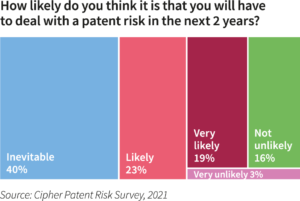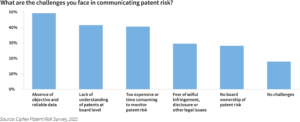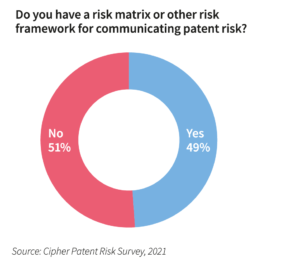Over 82% believe that it is more than likely that they will have an issue in the short term. Over half of patent owners, however, do not report on patent risk until there is a significant issue. There are many reasons given for this including the absence of reliable data and the lack of an understanding of patents at board level.
Overall, this suggests hidden danger. Whilst there is no shortage of patent expertise within organisations, it’s only when disaster strikes that the patent news travels fast and upwards. This paints a misleading picture of patent risk as Black Swans – of events that are rare, unpredictable and unquantifiable. Nothing could be further from the truth.
This is the first global risk survey on patent risk management and was conducted by Cipher in association with IAM. Here are the key findings:
- Patent risk is unavoidable for most patent owners, inevitable for many and generally not reported

Over 82% of patent owners think that it is likely that they will have to deal with patent risk in the next 2 years, with 40% reporting that patent risk is inevitable. When asked how often patent risk is reported, the majority response was only when there is a significant issue (56%) with an additional 5% saying that they never report on patent risk.
- Building a strong patent portfolio is the primary approach to patent risk mitigation, but only as part of a holistic risk strategy

Over 90% of survey respondents identified the building of a strong portfolio as the best way to mitigate patent risk. Other strategies include contracts with suppliers and customers (65%) and licences and cross-licences (61%). There were no shortage of contenders when asked how patent owners would deploy additional patent budget to reduce patent risk. While both organic growth of their own portfolio and licensing are the top responses, there is widespread recognition of the importance of patent acquisition on the secondary market (53%)vitable. When asked how often patent risk is reported, the majority response was only when there is a significant issue (56%) with an additional 5% saying that they never report on patent risk.
- The main challenges when communicating patent risk include the absence of objective and reliable data and the lack of understanding of patents at board level

Almost 50% of survey respondents highlight the absence of reliable data as the main challenge when communicating patent risk. Previous Cipher Reports have identified the same issue in other areas of patent strategy (see Dispelling the benchmarking myth, March 2021). The other top responses are the expense and time involved in monitoring patent risk (40%) and the lack of understanding of patents at board level (41%).
- Half of patent owners have a risk matrix or framework but only use it when there is a significant issue

49% of patent owners report that they have a risk matrix or framework for communicating patent risk. A patent risk report will most commonly include assessment of competitors and your own portfolio. Patent risk reports primarily focus on own and competitor portfolios, with patent disputes and litigation often included.
Read the Key Findings here
Read the Full Report here
About the author:
 Nigel Swycher is CEO and co-founder of Cipher. Nigel’s background is as an IP lawyer, having been a partner at Slaughter and May, London for 20 years. Throughout his career Nigel has focused on the creation, defence and exploitation of IP assets, and helping companies, their advisers and investors understand the importance of intangible assets. Nigel is a director of ORoPO (the Open Register of Patent Ownership) and is a recognised as an expert by the IAM Strategy 300.
Nigel Swycher is CEO and co-founder of Cipher. Nigel’s background is as an IP lawyer, having been a partner at Slaughter and May, London for 20 years. Throughout his career Nigel has focused on the creation, defence and exploitation of IP assets, and helping companies, their advisers and investors understand the importance of intangible assets. Nigel is a director of ORoPO (the Open Register of Patent Ownership) and is a recognised as an expert by the IAM Strategy 300.


